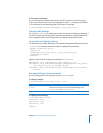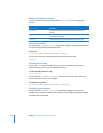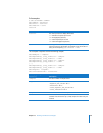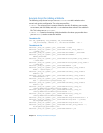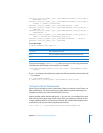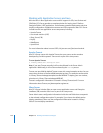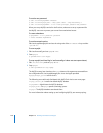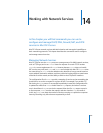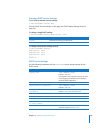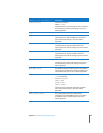
Chapter 13 Working with Web Technologies 215
To start JBoss, enter the following:
/Library/JBoss/3.2/bin/run.sh -c deploy-standalone
When you use this command, the system updates the Application Server pane of
Server Admin to reflect the status of JBoss. Sometimes, however, you might need to
click Refresh to show the configuration changes.
You can monitor the JBoss logs by reading the logs in /Library/Logs/JBoss/.
To stop JBoss, enter the following:
/Library/JBoss/3.2/bin/shutdown.sh
You can also stop JBoss by terminating the running run.sh command. JBoss uses
Tomcat as its default web server and servlet container.
MySQL Database
Mac OS X Server includes MySQL, a popular open source database that you can use
with web applications. This database is well suited for common web-related tasks, such
as content management and implementing web features, such as discussion boards
and guestbooks.
Before you can start MySQL for the first time, you need to install default files needed for
MySQL to run. For instructions, refer to the web technologies administration guide.
Mac OS X Server stores the files of the preinstalled MySQL version in the file system,
with executables in /usr/sbin and /usr/bin, man pages in /usr/share/man, and other
parts in /usr/share/mysql. In addition, the MySQL configuration file resides in /etc/
my.conf and the MySQL database in /var/mysql. By default the configuration file
doesn’t exist, so the default configuration is applied. You can find sample MySQL
configuration files in /usr/share/mysql/.
To have MySQL run every time the computer restarts, add the following line to the
/etc/hostconfig file:
MYSQL=-YES
There is no Server Admin support for the MySQL database management system, but
there is an application called MySQL Manager which provides a graphical way to install
the default database, set a root password, set the network option, and start and stop
the mysqld daemon. All these actions can also be performed from the command line.
To install the default database:
$ sudo /usr/bin/mysql_install_db --user=mysql -u mysql





